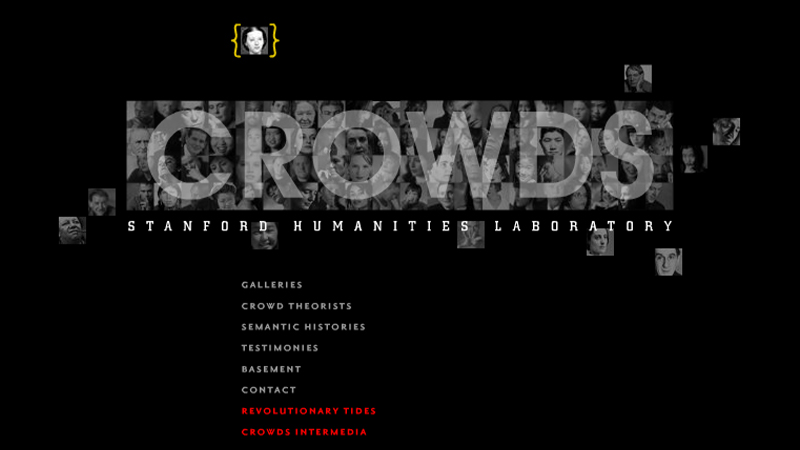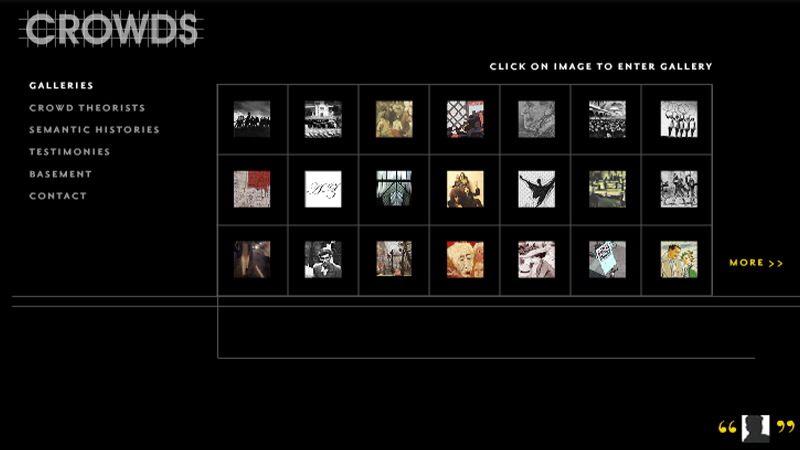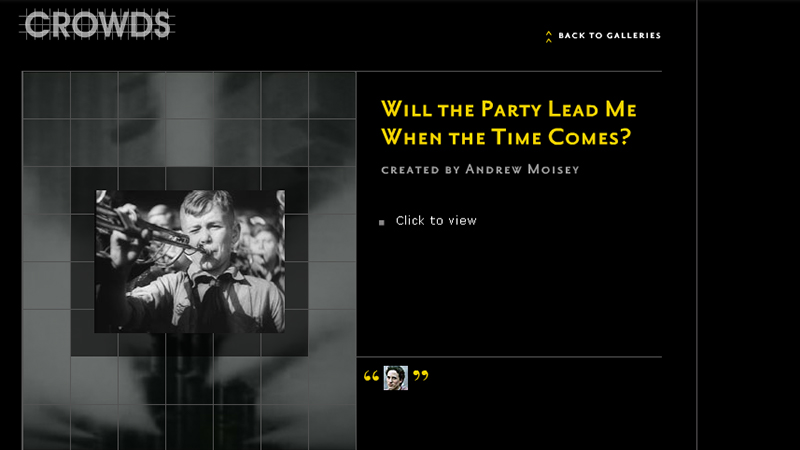Crowds was "[u]ndertaken as a multi-year research project of the Stanford Humanities Lab [and] productively considers . . . the crowd as a powerful cultural, political, and historical phenomenon. The site brings together an extensive database of writings, images, sound files, videos, and other artifacts in order to query whether or not, following Gustave Le Bon, we still live in 'the era of crowds.' Across the many points of view offered in the site (and in the ancillary materials that form the larger project), Crowds allows us to slice through various takes on how such public gatherings emerge and, more importantly, on how they function.
The project also explores the degree to which crowds evince a tension between the one and the many, the individual and the mass. In one of the site's 'testimonies', Michael Hardt distinguishes the multitude from the crowd, noting that 'the concept of the multitude is meant to name a set of singularities,' while the crowd often slips into the faceless mob or mass. In its very structure, in its lines and grids, Crowds draws upon this notion of singularity within unity, creating a rich, multi-perspectival investigation of public gatherings that at once respects the macro and the micro, the one and the many. Its bits and pieces, its individual players (from the furrowed brow of that marcher from Selma to the catty commentary of Jessica Burnstein), remain distinct even while they collectively paint a larger picture. The project stages an intermedial and transdisciplinary approach to its subject matter that simultaneously functions as a model of expanded scholarship, translating the work of the academy for broader public consumption, both on the internet and in various museum settings. Finally, in its invitation to curate a new gallery or add a new testimony, Crowds also creates a possible space for public dialogue, inviting someone to tell the stories of the anti-immigration protests that are unfolding as I type." – Vectors Journal Editorial Staff
Author's Statement
"Crowds is both the name of a research project carried out within the Stanford Humanities Lab in 2000-2005 and the title of a Flash-based website that serves as a bridge and space of overlap between the two other principal project outputs: a Crowds book (Stanford University Press, 2006) and Revolutionary Tides: The Art of the Political Poster 1914-1989, an exhibition and accompanying catalogue (Skira, 2005). All three are dedicated to exploring the decisive roles played by human multitudes in politics, society, and culture, with particular emphasis on the modern era of crowds, from the revolutions of the eighteenth century to the present.
How did early sociologists and psychologists understand processes of group action and reasoning? How have modern artists and writers translated abstract notions like 'the collective will' and 'popular sovereignty' into visual or narrative terms? How do the vocabularies employed to describe crowds shape and find themselves shaped by the sociohistorical contexts in which they gain currency? What sort of roles do media play in shaping images and myths of the collectivity? How do modern multitudes resemble or differ from their premodern counterparts? How have modern concepts of individualism and identity been altered by the rise of mass-based societies? Do we still live in what Gustave Le Bon famously proclaimed in his 1898 Psychology of Crowds as 'the era of crowds'?
These are the sorts of questions that the website addresses in three distinct but integrated sections. The entry section ('Crowds') contains four main categories of materials: virtual galleries curated by scholars and artists on various facets of crowds and modern life; reference entries on founding figures in the social sciences whose work has shaped the modern understanding of crowds; semantic histories, case studies of individual words in a dozen languages from ancient Greek to modern Chinese, and of their historical evolution; and a constellation of mini-essays in the form of testimonies regarding crowd experiences by contemporary writers and thinkers.
The second section ('Revolutionary Tides') provides a virtual counterpart to the experience of the exhibition, allowing the visitor to experience the same objects and object clusters in sequence, as well as providing in-depth documentation regarding individual posters. It is also accompanied by a documentary film (Art in Propaganda); an interview with East German poster artist Wolfgang Janisch; documentation regarding the 1/3rd scale reconstructions of several agitprop stations designed by the Russian Constructivist Gustav Klucis in 1922, featured in the exhibition installation; information regarding the catalogue and press coverage; and five video captures of actual visitor experiences of the inaugural version of the show.
The third section is entitled 'Crowds intermedia' and contains lead sections from the book's essays plus a bonus essay on the student protests of May 1968 (all in the form of pdf's); the Crowds Library, a searchable database that makes available to contemporary readers a wide array of social science writings on crowds from 1850-1927 in England, France, Germany, Italy, Spain, and the United States; and a streaming video version of the Crowds seminar, held on November 4-5, 2006 at the Stanford Humanities Lab. Whereas much of the book, exhibition, and website are historical in focus, the seminar was concerned with the present and future of crowds. Speculative in character, it assumed the form of an open conversation among artists, political activists, humanities scholars, social scientists, and technologists.
The Crowds project was one of the Stanford Humanities Lab's five flagship 'Big Humanities' projects dating back to 2000. From the outset, the project's heuristic hypotheses were as follows:
a) that the era of popular sovereignty, industrialization, and urbanization saw the rise of a constellation of new forms of mass assembly and collective social action that, born in the eighteenth century, reached their apogee in the first half of the twentieth century;
b) that these forms began to attenuate gradually in the second half of the century, due to the proliferation and ever increasing prevalence of virtual or media-based forms of assembly over physical assemblies in industrial/postindustrial societies, as well as to long-term trends promoting economic decentralization, suburban sprawl, increased mobility, and political disengagement; and
c) that this shift, rather than abolishing the equation between crowds and modernity, has reshaped it, channeling experiences of crowding in postindustrial societies into certain limited domains of civic and electoral ritual, entertainment, and leisure, while assigning to large-scale mass political actions a fallback function restricted to times of exception (war, acute social conflicts, and the like).
The initial project thesis was less one of rupture than of a process of specialization whose ultimate outcome is a gradual reduction of the role of physical crowds to that of an icon that circulates within a political economy characterized by the coexistence of media aggregation and bodily disaggregation. The icon in question is subject to a variety of uses and appropriations; its currency is sustained by contemporary resurgences of the prior history of marches, rallies, riots, and assemblies. It tends, however, to appear under an ever deepening patina of otherness and anachronism: 'otherness' inasmuch as the face of contemporary multitudes has increasingly become a foreign face associated with conflicts in Asia, the Middle East, and Africa relayed into first-world living rooms and bedrooms via electronic media; 'anachronism' to the degree that, even in the developing world, contemporary mass actions appear to have become ever more 'citational' — they quote from a prior, now irrecuperable heroic era of crowds — or designed for media audiences in remote locations — hence the prevalence of banners in English in non-Anglophone settings. The result is a growing decoupling of the once solid equation between crowds and contemporaneity.
By means of its rich stratification of contents, modes of discourse, media, methologies, and voices, the Crowds website seeks to explore the above terrain in a manner that weds macro- with microhistory, a solid and rigorous informational infrastructure with a no less rigorous critical and interpretive superstructure." -- Jeffrey T. Schnapp, Vectors, Volume 2, Issue 1, Fall 2006
Designer's Statement
"Though the two sites, Crowds and Revolutionary Tides, are interrelated, we approached their design very differently. Our objective with Crowds was first to reference the phenomenon of the crowd. We accomplished this with our opening Flash animation, which depicts, abstractly, a large public gathering and creates from that gathering the logo that brands the site. Since the purpose of the site, however, was to corral and disseminate information about 'crowds,' we also had to 'manage' the crowd once we established it — that is, we had to structure it and render it navigable. To do this, we relied on visible grid lines, a reference to official crowd assessment and control.
The grid-made-visible also plays a central role in the Revolutionary Tides site, though there its purpose is to create a virtual analog to a traveling exhibit. Through the use of gridlines and thumbnails to scale, the Posters page gives visitors to the site an overall sense of the exhibit's organization, scope, and scale. It also facilitates inspection and study of each of the exhibit's 119 posters." -- Bill Freias and Andrea Silvestri, Vectors, Volume 2, Issue 1, Fall 2006
Project Credits
"Jeffrey T. Schnapp, Crowds project director & principal investigator
Matthew Tiews, project co-PI, 2000-2005
Marisa Galvez, project manager
Heather Farkas, Revolutionary Tides exhibition coordinator
Website designed and built by Animated Design (Andrea Silvestri and Bill Freias) with the assistance of Dennis Schaaf and Jeff Aldrich)" -- Jeffrey T. Schnapp, May 19th, 2008
1 COPY IN THE NEXT
Published in Fall, 2006 by Vectors in Volume 2, Issue 1.
This copy was given to the Electronic Literature Lab by Erik Loyer in November of 2021.
PUBLICATION TYPE
Online Journal
COPY MEDIA FORMAT
Web


